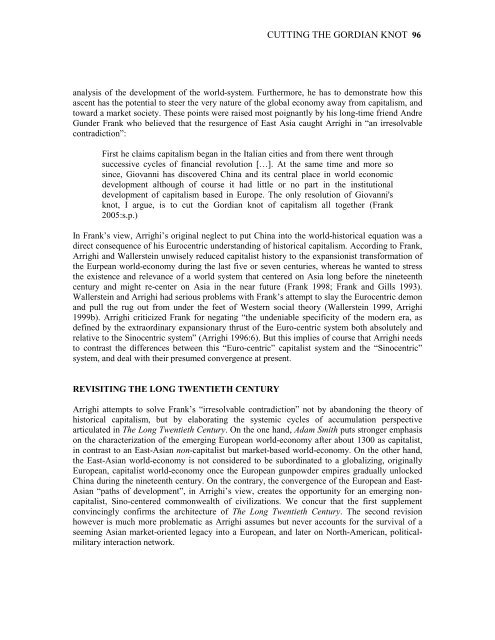Entire Volume 17 issue 1 - Journal of World-Systems Research ...
Entire Volume 17 issue 1 - Journal of World-Systems Research ...
Entire Volume 17 issue 1 - Journal of World-Systems Research ...
You also want an ePaper? Increase the reach of your titles
YUMPU automatically turns print PDFs into web optimized ePapers that Google loves.
CUTTING THE GORDIAN KNOT 96<br />
analysis <strong>of</strong> the development <strong>of</strong> the world-system. Furthermore, he has to demonstrate how this<br />
ascent has the potential to steer the very nature <strong>of</strong> the global economy away from capitalism, and<br />
toward a market society. These points were raised most poignantly by his long-time friend Andre<br />
Gunder Frank who believed that the resurgence <strong>of</strong> East Asia caught Arrighi in “an irresolvable<br />
contradiction”:<br />
First he claims capitalism began in the Italian cities and from there went through<br />
successive cycles <strong>of</strong> financial revolution […]. At the same time and more so<br />
since, Giovanni has discovered China and its central place in world economic<br />
development although <strong>of</strong> course it had little or no part in the institutional<br />
development <strong>of</strong> capitalism based in Europe. The only resolution <strong>of</strong> Giovanni's<br />
knot, I argue, is to cut the Gordian knot <strong>of</strong> capitalism all together (Frank<br />
2005:s.p.)<br />
In Frank’s view, Arrighi’s original neglect to put China into the world-historical equation was a<br />
direct consequence <strong>of</strong> his Eurocentric understanding <strong>of</strong> historical capitalism. According to Frank,<br />
Arrighi and Wallerstein unwisely reduced capitalist history to the expansionist transformation <strong>of</strong><br />
the Eurpean world-economy during the last five or seven centuries, whereas he wanted to stress<br />
the existence and relevance <strong>of</strong> a world system that centered on Asia long before the nineteenth<br />
century and might re-center on Asia in the near future (Frank 1998; Frank and Gills 1993).<br />
Wallerstein and Arrighi had serious problems with Frank’s attempt to slay the Eurocentric demon<br />
and pull the rug out from under the feet <strong>of</strong> Western social theory (Wallerstein 1999, Arrighi<br />
1999b). Arrighi criticized Frank for negating “the undeniable specificity <strong>of</strong> the modern era, as<br />
defined by the extraordinary expansionary thrust <strong>of</strong> the Euro-centric system both absolutely and<br />
relative to the Sinocentric system” (Arrighi 1996:6). But this implies <strong>of</strong> course that Arrighi needs<br />
to contrast the differences between this “Euro-centric” capitalist system and the “Sinocentric”<br />
system, and deal with their presumed convergence at present.<br />
REVISITING THE LONG TWENTIETH CENTURY<br />
Arrighi attempts to solve Frank’s “irresolvable contradiction” not by abandoning the theory <strong>of</strong><br />
historical capitalism, but by elaborating the systemic cycles <strong>of</strong> accumulation perspective<br />
articulated in The Long Twentieth Century. On the one hand, Adam Smith puts stronger emphasis<br />
on the characterization <strong>of</strong> the emerging European world-economy after about 1300 as capitalist,<br />
in contrast to an East-Asian non-capitalist but market-based world-economy. On the other hand,<br />
the East-Asian world-economy is not considered to be subordinated to a globalizing, originally<br />
European, capitalist world-economy once the European gunpowder empires gradually unlocked<br />
China during the nineteenth century. On the contrary, the convergence <strong>of</strong> the European and East-<br />
Asian “paths <strong>of</strong> development”, in Arrighi’s view, creates the opportunity for an emerging noncapitalist,<br />
Sino-centered commonwealth <strong>of</strong> civilizations. We concur that the first supplement<br />
convincingly confirms the architecture <strong>of</strong> The Long Twentieth Century. The second revision<br />
however is much more problematic as Arrighi assumes but never accounts for the survival <strong>of</strong> a<br />
seeming Asian market-oriented legacy into a European, and later on North-American, politicalmilitary<br />
interaction network.





